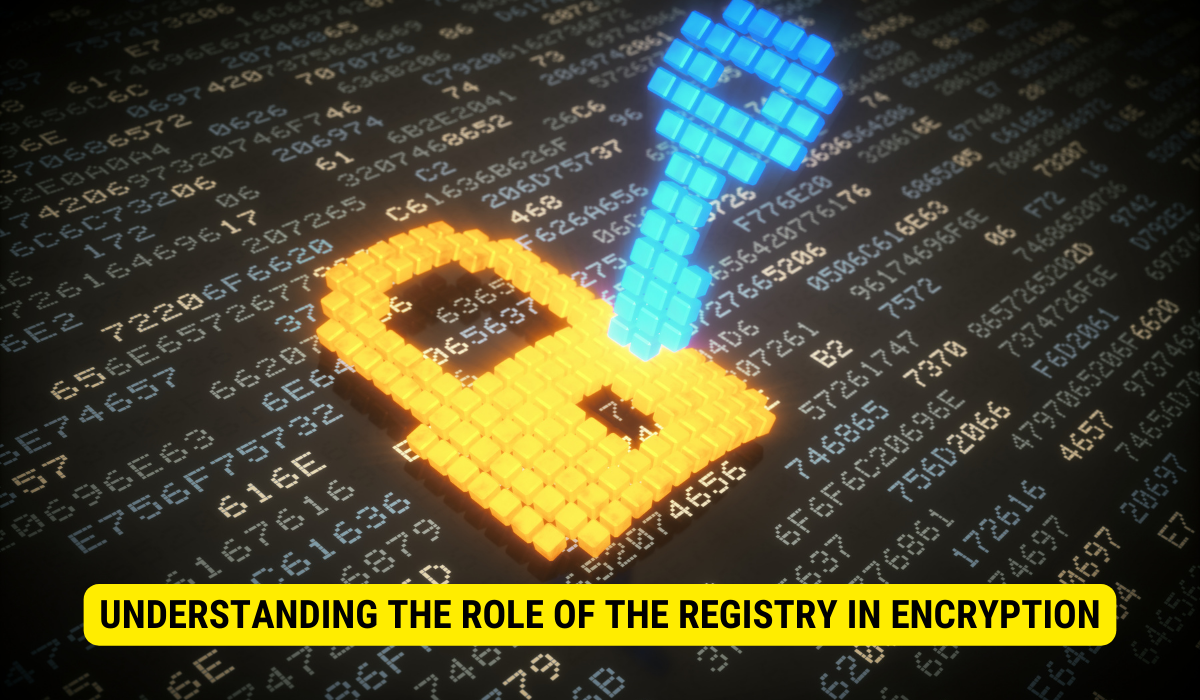The Windows Registry holds vital encryption-related data, including encryption keys, certificates, and encryption algorithm configurations. These elements ensure secure communication, data protection, and user authentication in the Windows operating system.
The Registry, an essential component of the Windows operating system, holds crucial information about various aspects of the system, including encryption. Understanding the role of the Registry in encryption is vital for system administrators, security professionals, and anyone concerned about data security. I will explore how the Registry interacts with encryption processes, the types of data stored in the Registry for encryption purposes, and the importance of this data in ensuring data security and system efficiency.
Understanding the Role of the Registry in Encryption
The Registry is a centralized database that stores configuration settings and data for the Windows operating system. It plays a crucial role in managing encryption-related information to enhance data security. Let’s delve into how the Registry and encryption work together.
The Basics of Registry and Encryption
Regarding encryption, the Registry stores various types of data, including encryption keys, certificates, and encryption algorithms. These elements form the foundation of secure communication and data protection.
Encryption keys are a fundamental component of encryption. They are used to transform plain text into cipher text, making it unreadable to unauthorized individuals. The Registry securely stores these encryption keys, ensuring only authorized users and applications can access them.
In addition to encryption keys, the Registry also stores certificates. Certificates are digital documents that verify the authenticity of a user or entity. They contain information such as the owner’s name, public key, and the certificate’s expiration date. By storing certificates in the Registry, Windows can validate the identity of users and ensure secure communication.
Furthermore, the Registry holds information about available encryption algorithms and their configurations. Encryption algorithms are mathematical functions that determine how data is transformed during encryption. The Registry keeps track of these algorithms, allowing the operating system and applications to select the most appropriate one for a given scenario.
How the Registry Interacts with Encryption Processes?
The Registry is a repository for encryption-related information used by applications and the operating system. It provides a centralized location for storing encryption keys and certificates, essential for authenticating users and protecting sensitive data. Additionally, the Registry holds information about available encryption algorithms and their configurations.
When an application needs to encrypt data, it can retrieve the necessary encryption keys and certificates from the Registry. This ensures that the encryption process is secure and reliable. The application can also query the Registry for information about available encryption algorithms and their configurations, allowing it to decide which algorithm to use.
Similarly, when data needs to be decrypted, the application can rely on the Registry to retrieve the appropriate encryption keys. By centralizing this information, the Registry simplifies the encryption and decryption processes, making them more efficient and secure.
The Registry is vital in managing encryption-related information in the Windows operating system. Securely storing encryption keys, certificates, and information about encryption algorithms enables secure communication, data protection, and user authentication. Understanding how the Registry and encryption work together is essential for maintaining a robust and secure computing environment.
Types of Data Stored in the Registry for Encryption
Let’s dive deeper into the specific types of encryption data stored in the Registry.
Regarding encryption, the Registry serves as a secure vault, safeguarding various critical components essential for maintaining the integrity and confidentiality of sensitive data. Let’s explore some of these components in more detail.
Keys and Certificates in the Registry

Encryption keys and certificates play a vital role in ensuring secure communication and verifying the identity of users. These cryptographic assets are carefully stored within the Registry, acting as digital guardians of sensitive information.
Whether symmetric or asymmetric, Keys are securely stored within the Registry, allowing authorized entities to encrypt and decrypt data. These keys are generated using robust algorithms and are protected by stringent access controls to prevent unauthorized access.
On the other hand, certificates serve as digital passports that validate the authenticity of individuals or systems. The Registry houses these certificates, enabling seamless verification and establishing trust between entities involved in encrypted communication.
Proper management of encryption keys and certificates within the Registry is paramount. Regular audits, key rotation, and adherence to industry best practices ensure encrypted data’s continued security and reliability.
Encryption Algorithms and the Registry
Encryption algorithms are the backbone of secure data transmission and storage. These algorithms define the specific mathematical operations performed on data to guarantee its confidentiality. Within the Registry, crucial information related to encryption algorithms is stored, allowing applications and the operating system to leverage the appropriate algorithm based on specific requirements and security standards.
The Registry holds configuration data for various encryption algorithms, such as Advanced Encryption Standard (AES), Rivest Cipher (RC), and Data Encryption Standard (DES), among others. Each algorithm has unique characteristics, strengths, and weaknesses, making it crucial to select the most suitable one for a given scenario.
By storing encryption algorithm information within the Registry, the operating system and applications can easily access and utilize the appropriate algorithm for encrypting and decrypting data. This centralized approach ensures consistency and compatibility across different systems, enhancing the overall security posture.
Furthermore, the Registry allows for managing and updating encryption algorithm configurations. As new vulnerabilities are discovered, or advancements in encryption techniques emerge, the Registry can be updated to reflect the latest security practices, ensuring that encrypted data remains protected against evolving threats.
As we can see, the Registry serves as a crucial repository for various encryption-related data, including keys, certificates, and encryption algorithm configurations. By securely storing and managing these components, the Registry plays a pivotal role in maintaining encrypted data’s confidentiality, integrity, and authenticity.
The Importance of Registry Data in Encryption
Now that we understand the data types stored in the Registry for encryption let’s explore why this data is crucial for data security.
Ensuring Data Security through the Registry
The Registry ensures data security by storing and managing encryption-related information. This includes sensitive cryptographic assets such as encryption keys and certificates. Secure storage and proper management of this data within the Registry are essential to prevent unauthorized access and maintain the confidentiality and integrity of encrypted data.
Regarding data security, the Registry acts as a fortress, safeguarding the encryption keys and certificates that are the backbone of secure communication. Without the Registry, these crucial assets would be vulnerable to theft or tampering, exposing sensitive data to malicious actors.
Furthermore, the Registry provides a centralized location for managing encryption-related data, making it easier for administrators to enforce security policies and ensure compliance with industry regulations. By consolidating encryption assets within the Registry, organizations can streamline their data security efforts and reduce the risk of misconfiguration or oversight.
The Role of Registry Data in Encryption Efficiency
Efficient management and access to encryption-related data within the Registry can significantly impact system performance. A well-optimized Registry that stores encryption configuration settings and data allows for faster retrieval and utilization of encryption assets. This ensures smooth encryption and decryption processes, minimizing any impact on system performance.
Imagine an organization with thousands of encryption keys scattered across different storage systems. Without a centralized Registry, retrieving the required key for encryption or decryption would be time-consuming, leading to data processing delays and potentially impacting critical operations.
Organizations can optimize their encryption processes by efficiently storing and retrieving encryption assets by utilizing the Registry. This improves system performance and enhances overall productivity and user experience. With faster access to encryption keys and certificates, authorized users can seamlessly encrypt and decrypt data, enabling secure and efficient communication.
Moreover, the Registry allows for easy scalability and flexibility in encryption management. As organizations grow and their encryption needs evolve, the Registry can adapt by accommodating new encryption algorithms, updating key management policies, and integrating with emerging technologies. This scalability ensures that encryption processes remain efficient and effective despite changing security requirements.
Managing and Accessing Encryption Data in the Registry
To maximize the benefits of Registry data in encryption, adopting best practices for managing and accessing this data is essential.
Best Practices for Accessing Registry Encryption Data
When accessing encryption data within the Registry, it is crucial to follow security best practices. This includes appropriate access controls, regularly auditing and monitoring access to encryption assets, and ensuring encryption keys and certificates are securely managed to prevent unauthorized access.
Common Challenges in Managing Registry Encryption Data
Managing encryption data within the Registry can present challenges. These may include handling frequent updates of encryption keys and certificates, ensuring proper backup and recovery mechanisms, and maintaining consistency across multiple systems. Addressing these challenges requires careful planning, regular maintenance, and adherence to industry best practices.
The Impact of Registry Encryption Data on System Performance
While encryption is crucial for data security, it can impact system performance. Let’s explore how encryption data stored in the Registry can affect system speed.
How Registry Data Affects System Speed?
Encryption processes can sometimes introduce additional processing overhead, impacting system performance. However, optimizing the Registry and implementing efficient encryption algorithms can minimize the impact on system speed. Balancing data security and system performance is crucial to ensure an optimal user experience.
Balancing Encryption Needs and System Performance
To maintain a balance between data security and system performance, it is necessary to assess the specific requirements of your system and implement appropriate encryption strategies. This includes evaluating encryption algorithms, considering hardware acceleration options, and monitoring system performance to ensure optimal operation.
In conclusion, the Registry holds crucial data regarding encryption, including keys, certificates, and encryption algorithms. Understanding the role of the Registry in encryption processes is vital for maintaining data security and system performance. By following best practices for managing and accessing encryption data within the Registry, organizations can ensure their sensitive information’s confidentiality, integrity, and availability. Regular optimization and monitoring of the Registry can help balance data security and system performance, ensuring a seamless user experience.
FAQs:
What is the primary role of the Registry in encryption?
The Registry is a centralized database storing configuration settings and data for encryption, facilitating secure communication, data protection, and user authentication.
What types of data related to encryption are stored in the Registry?
The Registry securely stores encryption keys, certificates, and information about available encryption algorithms.
How does the Registry interact with encryption processes?
The Registry provides a centralized location for encryption keys, certificates, and algorithm configurations. Applications can retrieve and use this information for secure encryption and decryption processes.
Why is the data in the Registry crucial for data security?
The Registry safeguards encryption keys and certificates essential for secure communication. Proper storage and management of this data within the Registry prevent unauthorized access and ensure data integrity.
Can encryption processes impact system performance?
Yes, encryption can introduce processing overhead. However, optimizing the Registry and selecting efficient encryption algorithms can minimize the impact on system performance.
Key Takeaways:
- Central Repository: The Windows Registry is a central repository for encryption-related information, enabling secure communication and data protection.
- Types of Data: The Registry holds encryption keys, certificates, and configurations for various encryption algorithms.
- Efficiency and Security: Proper management of encryption data within the Registry ensures efficient encryption/decryption processes and enhances data security.
- Challenges: Managing encryption data in the Registry can present challenges like frequent updates, backups, and consistency across systems. Adhering to best practices can address these.
- System Performance: While vital for security, encryption can affect system speed. However, with an optimized Registry and suitable encryption strategies, a balance between security and performance can be achieved.
Conclusion:
The Windows Registry ensures data security by holding vital encryption-related components like keys, certificates, and algorithm configurations. Understanding its role and efficiently managing this data is crucial for data security and optimal system performance. Organizations should diligently access and manage this encryption data, balancing stringent security measures and system efficiency.
